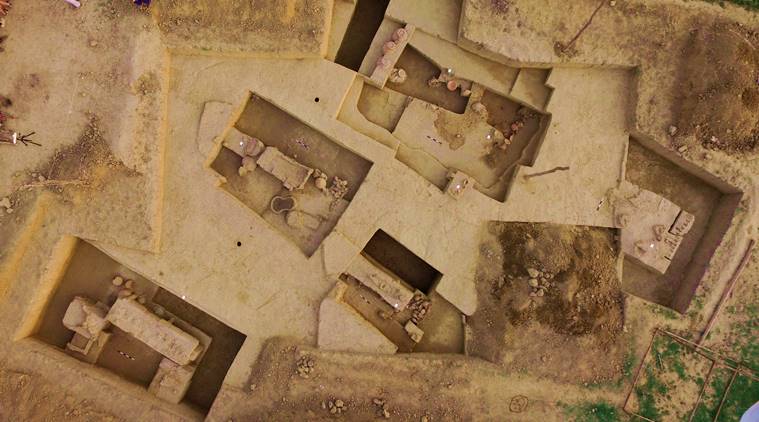 ‘There is no conclusive evidence to link any of this to the Mahabharata as yet, but the discovery is significant.’ (Source: Express Photo by Divya A)
‘There is no conclusive evidence to link any of this to the Mahabharata as yet, but the discovery is significant.’ (Source: Express Photo by Divya A)
Wooden coffins inlaid with copper, remains of a chariot, ivory combs and swords — the archaeological findings at Sanauli village in western UP’s Baghpat has the making of an exciting thriller, whose roots lie over 4,000 years in the past. What started as a trial excavation by the Archaeological Survey of India (ASI) in March this year, after villagers reported pieces of copper and clay pottery on their fields, has led to the unearthing of chariots and sophisticated weapons, that date back to the pre-Iron Age, from a 10×15 m patch of agricultural land in the sugar belt.
“What we have stumbled upon here has not been found in the entire Indian subcontinent till date,” says ASI director, Sanjay Kumar Manjul, who headed the project. The team dug three pits on the patch and found eight burial sites, just a metre below the fertile farmland. Three of them are elaborate coffin burials, complete with shields, mashaal (torches), two chariots, antenna swords and copper pottery, arranged ritualistically near the head and feet of the skeleton, indicating that the coffins were of people of considerable social importance. Archaeologist Arvin Manjul, a collaborator on the project, says, “In 2004-5, the ASI had discovered 116 graves a mere 100 m away from this site. We were expecting to find a habitation site corresponding to those graves here. We were startled to find more graves. The entire area is likely to be a necropolis.”

Even as burial pits were excavated at Rakhigarhi, Kalibangan and Lothal in the past, this is the first time that chariots have been discovered in burial pits. This has led to great excitement among historians and archaeologists. Those supporting the theory of Aryan invasion say horses were brought to India by the Aryan army around 1300 BC. The theory may be challenged if archaeologists can establish the presence of horse-driven chariots dating back to 2000 BC.
Eminent historian Irfan Habib, says, “During previous excavations pertaining to the Indus Valley Civilisation, toy bullock carts were found, indicating that they had developed bullock carts during the mature Harappan era.” Habib says that if carbon dating places these finds to that period — 2000-2500 BC — it would imply that these were likely the bullock carts used by the Harappan traders as transport as well as for fights.
While the debate can only be settled by concrete findings, the excavated material has been brought to Delhi for further examination. Besides chariots and swords, the team has also found ivory combs with peacock motifs near a female skeleton, and ornamental beads in gold and silver near the skull. A dog’s skeletal remains have also been discovered in a pit, along with ritualistic pots near the dog’s head.
 Besides chariots and swords, the team has also found ivory combs with peacock motifs near a female skeleton. (Source: Express Photo by Divya A)
Besides chariots and swords, the team has also found ivory combs with peacock motifs near a female skeleton. (Source: Express Photo by Divya A)
As the first pictures emerged in the local media last week, swarms of OB vans and curious villagers rushed to the site, many of them proclaiming that evidence of the Mahabharata’s existence has finally been found in Baghpat. An anchor of a regional television channel even declared it to be “Arjun ka rath” on live television, even as officials on the ground kept issuing denials.
Manjul reiterates the standpoint. “There is no conclusive evidence to link any of this to the Mahabharata, but the discovery is significant.” The sophistication of the weapons and jewellery, along with the chariots, indicate that Indian civilisation might have been on a par with other ancient civilisations like Mesopotamia and Greece, and that the wheel was discovered earlier in the region than what history has accounted for so far. It also indicates that, perhaps, a warrior class populated the floodplain between Ganga and Yamuna at the time.
Story continues below this ad
So who were these people? Amit Rai Jain, director of the Baraut-based Shehzad Rai Research Institute, who has authored several books on the region’s archaeology, is convinced that these people were from the “era of the Mahabharata”. “According to the Mahabharata, Lord Krishna had asked for five villages for the Pandavas — Paniprastha (present-day Panipat), Sonaprastha (Sonipat), Vrikshprastha (Baghpat), Indraprastha (Delhi) and Tilaprastha (Tilpat). This corresponds to present-day Baghpat. These graves may not be of the Kaurava or the Pandava kings, but could be of their army commanders,” he says.
The ASI director dismisses this theory. “These findings open up a tremendous scope for further excavation and research. But it is not possible to conclude anything just yet,” he says. In fact, Manjul points to a Vedic link. “In the Rig Veda, there is a mention of both kinds of funeral practices — cremation and burial. These findings could have some connection with the Puru warriors mentioned in the Rig Veda (around 1500 BC),” he says.

 ‘There is no conclusive evidence to link any of this to the Mahabharata as yet, but the discovery is significant.’ (Source: Express Photo by Divya A)
‘There is no conclusive evidence to link any of this to the Mahabharata as yet, but the discovery is significant.’ (Source: Express Photo by Divya A)
 Besides chariots and swords, the team has also found ivory combs with peacock motifs near a female skeleton. (Source: Express Photo by Divya A)
Besides chariots and swords, the team has also found ivory combs with peacock motifs near a female skeleton. (Source: Express Photo by Divya A)





























